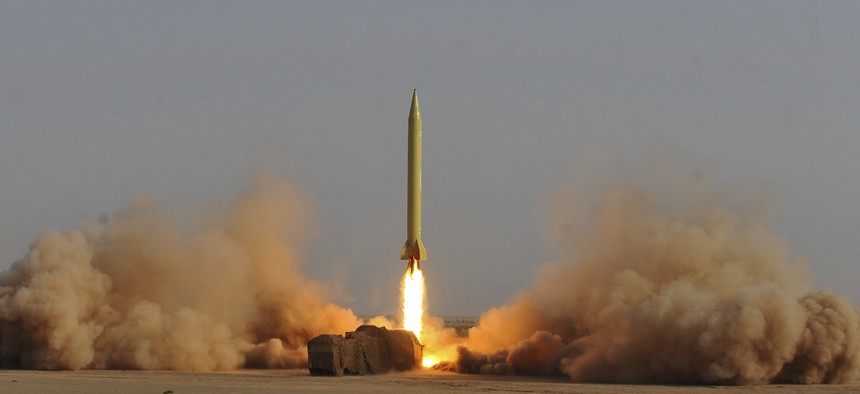
An Iranian Shahab-3 missile is launched during military maneuvers outside the city of Qom, Iran, Tuesday, June 28, 2011. AP Photo/ISNA, Ruhollah Vahdati
What a Yemeni Missile Teaches Us About the Iran Deal
The U.S. and its regional partners are going to have to work a lot harder because missiles are missing from the P5+1 nuclear negotiations.
One may be forgiven for not noticing that Saudi Arabia on June 6 used Patriot missiles to intercept a Scud-class missile fired by Houthi rebels in Yemen. Besides adding the Saudis to the very short list of states that have intercepted a ballistic missile fired in anger, the episode holds several lessons about regional security concerns — and in particular, about Iran’s ongoing missile development.
Among them: the U.S. and its regional partners are going to have to work a lot harder because missiles are missing from the P5+1 nuclear negotiations.
Iran’s missile program, the largest and most diverse in the region, includes the 2,000-km Shahab-3, the solid-fuel Sejil of similar range, shorter-range rockets, anti-ship missiles and a new long-range cruise missile. A comprehensive approach to Iran’s nuclear capability would have dealt with its longer-range ballistic missiles, likely its preferred nuclear delivery system. The State Department originally pushed to include them in negotiations—but Tehran pushed back and Washington backed down. This is unfortunate; Iran’s retention of long-range missiles makes more problematic its likely future status as a threshold nuclear weapons state.
Missile limitations are sometimes seen as the lesser stepchild in the nonproliferation family, but they have actually been instrumental in arms control. Early arms-control treaties with the Soviets did not regulate nuclear weapons or enrichment at all, but rather the missiles and bombers to deliver them. Other nations that agreed to give up nuclear programs — for example, South Africa and Libya — did so in tandem with missile limitations. In general, long-range missile development has been an excellent historical indicator of both intent to acquire nuclear weapons and of good faith in agreements to roll such programs back. And missile testing and possession is easier to spy upon than, say, underground nuclear enrichment, materials, assembly, storage, or testing.
But since the better diplomatic solution to Iran’s longer-range missiles seems to be off the table, the U.S. and our regional partners will likely have to pursue more difficult and expensive counters.
The first step will be to continue to degrade missile development — indirectly, through the continued enforcement of missile sanctions, and directly, with covert sabotage. Both will clearly be harder when sanctions are lifted and relations more normalized. The Yemeni missile episode reminds us of the limits of counter-proliferation agreements. In 2002, the U.S. boarded the North Korean ship So San, in which 15 Scuds were hidden under sacks of cement. Yemen finally admitted that it bought the missiles, so under international law they were allowed to be delivered.
Second, America’s regional partners in the Middle East must improve their ability to destroy Iranian missiles on the ground. The Yemen missile launch demonstrates both the value and the limits of this “left-of-launch” approach. Saudi aircraft had already struck the believed locations of Houthi missiles and likely got most of them. After the launch was detected, aircraft destroyed the launcher, precluding further attack.
But this episode, along with numerous failed “Scud hunts” in Iraq, show that finding launchers isn’t easy. And in North Korea, in 2006, intelligence assets focused on the peninsula were prepared for the conspicuous Taepo-Dong launch—but were surprised when Pyongyang fired shorter-range mobile missiles into the sea. The clunky Scud missed by the Saudis would have been harder to hide than Iran’s mobile solid-fuel missiles. For this mission, partners are likely to want F-16 Block 60s and other standoff weapons.
The third needed response will be preparing to destroy missiles after launch. Saudi Arabia, UAE, Kuwait, and Qatar have already spent billions on Patriot and THAAD defenses, and more spending is in the pipeline for both sensors and shooters. Missile defenses are now established as part of a mix of warfighting capabilities. As seen with Yemen, defenses ride out an early missile attack until offensive forces can strike.
The joint statement issued after the recent GCC summit reiterated a call for missile-defense cooperation that would yield more protection than states acting independently. Cooperation should include real-time information sharing, especially early warning and tracking; purchase of additional sensors and interceptors, including by the GCC as an entity; and development of operational concepts to predesignate who shoots at which incoming missiles and when.
Even if a nuclear deal meets every White House goal, the potential for Iran to break the deal and quickly build a nuclear weapon means that the U.S. and partners in the region will have to maintain or acquire better capabilities to hedge President Barack Obama’s bet. It won’t be cheap or politically easy, but this is the price of omitting delivery systems from key discussions.
NEXT STORY: After Ukraine, NATO's Chance for a New Normal
